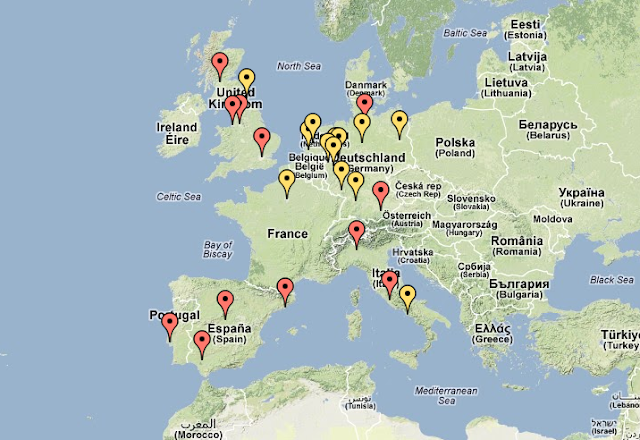You could cross [the Irwell] via the swanky bridge designed by instant regenerator Santiago Calatrava but to get the true measure of the place it's best approached through the bleak dual carriageways, retail parks, office complexes and industrial estates of Trafford, where you get to see the bizarre Yeltsin-Constructivism of Old Trafford Stadium, redesigned by local architects Atherden Fuller in the late 1990s. This freakish mix of domineering symmetries and bared structure is heralded by a statue of Denis Law, George Best and Bobby Charlton, the United Trinity locked in embrace. Their faithfully rendered skinny bodies and skimpy 1960s kit contrasts vividly with today's lumbering soccer supermen, leaving them looking dainty and rather camp, with a slight mince to their celebratory pose.I Googled the phrase "Yeltsin-Constructivism" to find out what it meant and came across what must have been an earlier draft of the same paragraph, in which he talks about "the bizarre Yeltsin-Constructivism of Old Trafford, where domineering symmetries, bared structure and outrageously kitsch statues prove the enduring ridiculousness of the world's least interesting football team."
It's worth pointing out that in the book itself, Hatherley makes clear his apparent lack of interest in football-in-general when he complains about the conversion of the Urbis building into the National Football Museum: "It's difficult to imagine any fate more depressing."
Luckily, what Hatherley appears to lack in interest in football (and its role in the city's regneration), he makes up for in his architectural descriptions. He appears to be the only person to ever have used the term "Yeltsin-Constructivism" and what a great, unique way to describe what is probably Manchester's most iconic and important building, the centre of a global commercial empire and (despite what Hatherley appears to think) probably the most enduring narrative in world football.
It makes you wonder whether the architects consciously had the idea of some sort of postmodern 1990s form of Russian Constructivism in mind when they redesigned the stadium. Whilst there is no record (on Google) of anyone using the term "Yeltsin-Constructivism," there is a group called the New Constructivists, whose aim is to explore constructivism's "stylistic relevance to the contemporary world in terms of the use of line, planes, precision and formal ordering of visual elements."
This wouldn't have been the first time Manchester United have been associated with the imagery of the Soviet Union, and I don't mean the Red Army's 1974 "plan to invade Manchester." United fans have long referred to themselves as the Red Army. The Republic of Mancunia has recently become a popular slogan, with its attendant image of clenched fists and red stars (not to mention the occassional hammer and sickle). In a recent article on the football website In Bed With Maradona on Manchester United's left-wing tendency, I suggested that this may have stemmed from the industrial character of the area around Old Trafford (visited in 1961 by the cosmonaut Yuri Gargarin).
It's hard to imagine any other area in the UK making such a play on this perceived left-wing identity - "red" in more than one sense of the word. The irony is obvious and many have pointed it out in response to the IBWM article. The club whose fans align themselves with the imagery (if not necessarily the politics) of the far left (possibly reflected in the design of the stadium), are also famously successful at global marketing and closely identified with huge sponsorship deals with the likes of insurance giants AON, car manufacturers Chevrolet, logistics firm DHL and watchmakers Hublot. A far cry (as Hatherley seems to be hinting at) from the innocent world of Law, Best and Charlton, modest salaries and sponsorless shirts.
Football is the global sport and Manchester United are its common currency. Its brand strategists have successfully tapped that huge market and Old Trafford is the symbolic centre of what I earlier described and what can only be described as an empire. It stands alongside the Nou Camp, the Bernabeu and the San Siro as a monument to European club football's global dominance. With the term "Yeltsin-Constructivism," Owen Hatherley may have summed up its unusual aesthetic.



